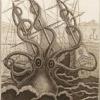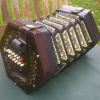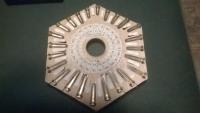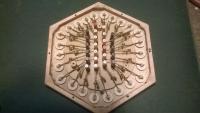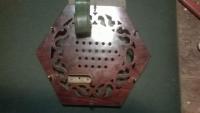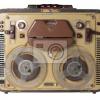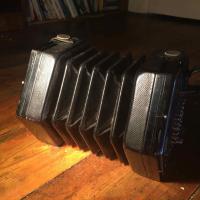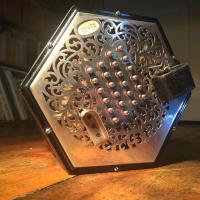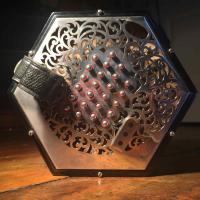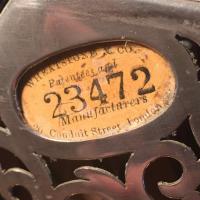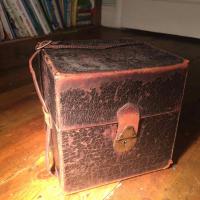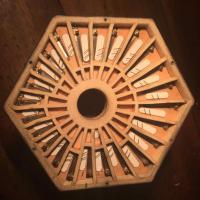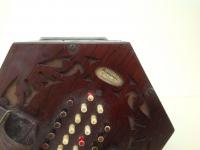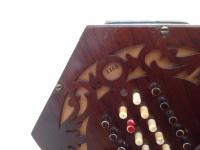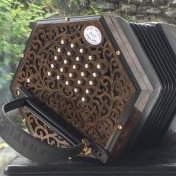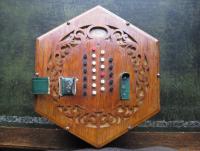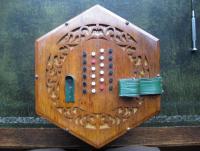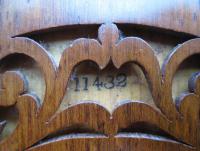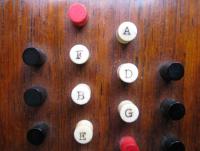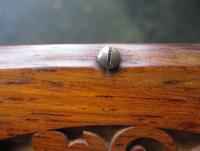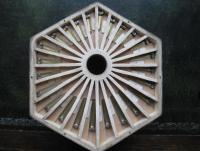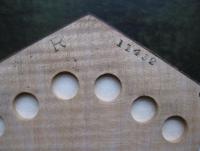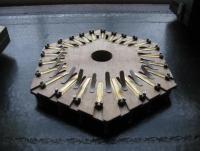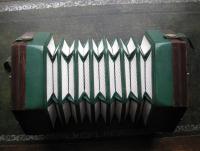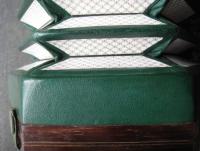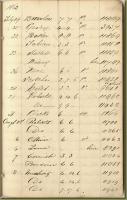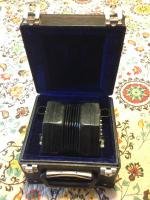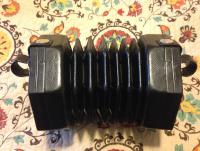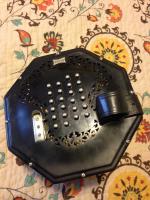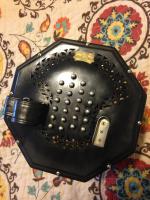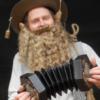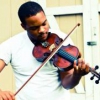Search the Community
Showing results for tags 'English'.
-
I was planning a track to record this week when the The East Neuk of Fife sprang to mind from J. Scott Skinner’s ‘The Harp and Claymore’ Collection. I was just going though the variations when I noticed the tempo – 136bpm! It is ridiculous. I actually think it is too fast – I preferred 130bpm but in homage to the great man and composer here it is at 136 ? You can hear and watch it here. http://simonthoumire.com/the-east-neuk-of-fife-at-136bpm/
-
Grateful to know if anyone has any English 48 button concertina with a serial number close to 112. I am trying to identify the maker. Rosewood ends. Riveted action. Square ended reed shoes. Not Wheatstone or Lachenal. Only mark other than the s/n are 'L' and 'R' marks for the ends.
-
It's a Stagi English A 48 S Tenor without decorations, it has a stagi bag with it. The bag cost about 60 USD(but I paid in SEK, so it's approximately), the concertina itself cost 653 USD(paid both in SEK ofc) It's barely played and I think it had decent quality, but I can't say since I do not know much about these. Been in it's bag for most of the year. The reason for selling it is not due to any disappointments with the product but because I can't play it very well at all. I am a keyboardist and I'm not very experienced in that area yet either. So I'm probably going to buy a melodica to "replace" it, being a portable free reed instrument as well, difference being that I know how to play keys and have had experience with playing melodicas before. If anyone has any other idea of where I could ask on the net about the price, I'd be happy to receive a link to the place. EDIT: The title was cut off, this thread is asking about what price I should sell it at.
- 7 replies
-
- concertina
- stagi
-
(and 2 more)
Tagged with:
-
I have recently acquired this instrument, which is missing it's fret baffles and hence also missing the RH end label. After opening up to check the S/n, I noticed that the inner reed pan paper dials had been so cut as to remove the maker's name and address. I thought this was a bit strange, as other 're labelled' Lachenals which I have seen, still retain the full reed pan labels. Has anybody seen this on any other instruments, or offer any explanation as to why this might have been done? Also of note is the fact that there are valves fitted to all the highest notes, I had understood that this was incorrect, but have also noted it on quite a few similar instruments in the Concertina Museum collection? What is the best source of info for Lachenal Serial number production dating, I have tried to date this but have been unable to find anything helpful on line (my internet search skills seem to be lacking!) I include photos of the action and fret end to aid indentification/dating:
-
Can anyone advise where these very small diameter counter sunk steel wood screws can be obtained in the UK (in small numbers!)... ? Also replacement case hinges and their screws too?
-
This chart was originally handwritten by Dennis Gentofte and enclosed in the muslin concertina bag with my 18 button Hohner English concertina. It shows the 18 button concertinas right and left hand buttons and 3 scales. I have made it available for anyone who would like to have it. Many thanks to Dennis, and this forum. 18 Button English Mini Concertina.pdf
-
I recently took up this lovely and catchy broadsheet ballad once again, thereby hopefully implementing some good advice from fellow musicians (starting with raising the pitch by two semitones): Now The Tyrant Hath Stolen Please comment, I'd appreciate that! Best wishes - Wolf (typo corrected)
- 6 replies
-
- Ballad
- Self-Accompaniment
-
(and 1 more)
Tagged with:
-
So here's another tune revisited, in fact my very first "great" English ballad (which I compiled and recorded for the first time back in February 2014 as it turned out): Barbara Allen Once again, pitch raised by two semitones, more breath... Best wishes - Wolf Stuart - thank you again for this great version (as to the tune, and harmonies in particular)!
-
For Sale: Wheatstone Aeola 48 button English Concertina. Serial #24873, Key of C. I purchased this Concertina from Barleycorn Concertinas in England, and recently (2013) had it serviced at The Button Box in Massachusetts. Falling within the dear and lost years periods of the Wheatstone company, this Ebony ended concertina has unique fretwork, and is in perfect playing condition. All buttons play clearly and in perfect pitch. I am located in the Western United States. I have never used this forum before, but am aware of the 2% donation policy. I am located in Montana but will be traveling to Southern California next week and can bring the instrument with me.
- 6 replies
-
- wheatstone
- aeola
-
(and 3 more)
Tagged with:
-
DELETED
-
- concertina
- English
- (and 4 more)
-
I'm playing the duet these days and two systems is more than my brain can deal with! So.... Selling my Wheatstone 48 key English Concertina, I believe it's a Model 22. Serial Number 23472.... Pics below. In great condition. Plays very well. 5 Fold Bellows (Look like they're the originals) Metal ends are in very good shape, no real wear. There's 2 bowing valves, one on each end. Steel reeds and all look original. Tuned to A440 concert pitch. Professionally re-valved this year. Original leather case still solid and useable. Looking for £2250. Offers will be considered. The concertina is in the South of England, I'm happy to try and meet so buyers can try it first. PM me if interested. Thanks.
-
- wheatstone
- for sale
-
(and 3 more)
Tagged with:
-
I have recently become the custodian of this instrument, the seller believes it to be a Wheatstone, only labelled and sold by Prowse... At this web page http://www.concertinamuseum.com/CM00254.htm there is a similar instrument with an slightly earlier serial number, with the detail that the maker is Keith, Prowse & Co. Does anyone have any knowledge as to the activities of Keith, Prowse & Co, did they actually make any instruments? The label at least says 'Manufacturers'. Was posing as being a maker, when you were really a distributer/retailer a known practice of these times? If Keith and Prowse were not makers, then who might have made this concertina (S/n 1155) and how old is it likely to be? (Edited on 25/11/15, to insert the comma between 'Keith' and 'Prowse', to change 'he' to 'they' etc, as I had mistakenly read the label as being Keith Prowse & Co (assuming Keith to be a first name).
-
A friend of mine has owned this instrument for many years but never learnt to play it. Now he wants to sell it to help fund a building project. I’ve offered to help him. My question is should he sell it in its current condition or refurbish it first? Normally my advice would be the latter since most people want an instrument they can play without the delay and uncertain cost of repairs etc. In this case, though, the instrument seems to be virtually untouched since the day it was made. It might be more attractive to buyers in that condition. The serial number (11432) suggests it was built in about 1860. Wheatstone’s sales ledger shows that it was sold in July 1862. It’s the most expensive intstument on the page which presumably gives some indication of its quality. It seems to have spent most of its life in its tea-caddy case in benign environmental conditions. There’s no sign of cracking, warping or swelling in the woodwork. The bellows are pristine. There are no nail marks round the buttons and the buttons show no signs of wear. The end bolts are undamaged and there’s no damage to the wood round them. Open it up and the inside is as clean as the day it was built. All 96 reeds play. The only two issues are one broken thumb strap and half the valves curled up from being stored on its side. The broken thumb strap was almost certainly caused by pulling it out of the case after someone jammed it in by not aligning the knurled thumb screws with the groove in the case. Tuning: It sounds pretty good. I’ve been able to check some notes against a guitar tuner and these are between about 5 and 25 cents sharp. The D# is different from the Eb and likewise the G# and Ab. So it is probably in old high pitch and some sort of meantone tuning - possibly never touched since it was made. I’d welcome any advice before putting it up for sale.
-
For Sale: brand new Jackie concertina. I bought a month ago http://www.concertinaconnection.com/jackie-jack.htm but later realized that I was more appropriate Duet. Yes, I know that it is possible to exchange, but the mean distance shipment will quite expensive, and I'm looking for an opportunity to sell its close to buy a new one. Location - Russia. I hope anyone interested. By the way, it would be great just to exchange my Jackie to Elise Hayden Duet.
-
- concertinajackie
- wakker
-
(and 3 more)
Tagged with:
-
For Sale: Wheatstone Aeola 48 button English Concertina. Serial #24873, Key of C. I purchased this Concertina from Barleycorn Concertinas in England, and recently (2013) had it serviced at The Button Box in Massachusetts. Falling within the dear and lost years periods of the Wheatstone company, this Ebony ended concertina has unique fretwork, and is in perfect playing condition. All buttons play clearly and in perfect pitch. I am located in the Western United States. I have never used this forum before, but am aware of the 2% donation policy. I am located in Montana but will be traveling to Southern California next week and can bring the instrument with me. Please see four detailed pictures below:
-
- Wheatstone
- Aeola
-
(and 7 more)
Tagged with:
-
I'm trying to fix a slow reed on my brass reeded English concertina. (It's the a flat on the right; on the push) I'm pretty sure that the problem is that the gap between the reed and the frame is too small. I've done one round of opening the concertina up and pushing on the reed with toothpick. I was pretty gentle, pushing the tip of the reed maybe one millimeter out from the reed frame; at the end of the process I didn't see a clear change in how the reed sat. Obviously, this hasn't fixed the problem. To my untrained eye, there isn't really any gap at all; this would concern me except that the a flat reed wasn't obviously different from the adjacent a natural. How far/hard should I push on a reed to try to modify the size of the gap?
-
I will be at BB&M in Aberdeen this weekend. I will have for sale a metal-ended Aeola TT (30964) and a wooden-ended Lachenal New Model 48, both in excellent condition having been fettled respectively by Andrew Norman and David Robertson. I'll be around all the weekend except for Sat evening.
-
I've been searching for an hour comparing the Aeola English system Tenor and Tenor-Treble (model 17 and model 19) Which is right for me? I have the note range figured out but can't find anything specific on the size and weight comparison. Can soneone give me the size (across the flats) of both a 48K treble and a 56K tenor-treble Aeola please? Maybe a Model 22 too as well please. Actually... If this hasn't been done before, let's compile a chart comparing the different models. If it has been done please point me in the right direction or PM me for my email to send it to me please. I am mostly interested in Wheatstone but why not open it up. Please let's stick to English system though. Every few days I can put the info into a summary post. What do you say? Not the primary concern when choosing an instrument of course but it does come into it. I think this could be some very useful data compiled into one place. Please help Type (ex: tenor, tenor-treble, tenor etc,) Model # (ex: Model 17 for 48K treble Aeola etc.) Serial # (optional but especially useful if no model #) Number of keys Note range Features (ex: wrist straps, thumb strap to note position, etc.) Type of ends (ex: ebony, raised ebony, metal, etc.) Number of bellow folds Size (distance across the flats) Weight Thanks.
- 64 replies
-
- Tenor
- Tenor-treble
- (and 7 more)
-
Wanted - 48 Button English To Learn On - West Coast Canada Or PNW, Seattle area. Edit: I am now actively searching for a Lachenal Edeophone 48 key with the large reed pan hole from the late 1920s. I am really enjoying the English concertina but my bone button instrument is in terrible condition and not worth getting professionally restored. I have been told that the Edeophone has the best balance of all the vintage concertinas for the type of music I want to play. It is very important to me that the steel reeds have never been tuned, that it is in old high pitch. The rest of the instrument can be rough as long as it is able to be restored. Please let me know if anyone has something like this or knows of one for sale. I prefer to buy locally in Canada but would certainly be open to getting the right instrument shipped from the UK or the USA. Thanks, John Message me through this forum please.
- 6 replies
-
- English
- Wheatstone
-
(and 5 more)
Tagged with:
-
SOS The chances are slim for me to receive my English concertina recovering in England with Dr. Dipper ... I will be at the Mariposa Folk Festival in Ontario next weekend with my band... If you have an English concertina sleeping at home and you want to save a life, I'm your man! I cross my fingers... David Berthiaume info@reveillons.qc.ca
-
- english
- concertina
-
(and 1 more)
Tagged with:
-
Here's a couple of songs to get the toes tapping. The first is one is fairly well known in Oz and was done by Australian country singer Kasey Chambers, an inane song of lost love, her bloke takes off with another gal. I was wondering about changing the words to make it gender correct for a male singer but then realised I didn't have to. These days it's not unusual for a wife or girlfriend to dump their bloke and take up with another lady! Kasey sings it with a contrived American accent. I had to be careful to avoid that country twang. Here ya go. https://www.youtube.com/watch?v=Mj4jIILT1vI Here's another, the old San Francisco Bay Blues. https://www.youtube.com/watch?v=WIch3lDVzC0 I like that these songs are a bit boppy. Both have a click beat, you'll see. I've been trying to develop a style of rhythm with my playing but am undecided about whether I'm really happy with it. Sometimes the chording sounds a bit too full perhaps. They're recorded with my little portable digital recorder which probably doesn't help.
-
Hello all! I am new to the forum and to the english concertina. I've been playing for almost two weeks now. When I'm not working through a tutor book I have come to really enjoy practicing modal scales. It is really helping me to become more acquainted with the notes on the instrument. Anyone else use modal scales during their practices? What other exercises would you suggest for a concertina beginner?
- 10 replies
-
- english
- concertina
-
(and 2 more)
Tagged with:
-
I'm looking to buy my first english concertina today and I'm going to buy a Stagi English A48-S. The question is if I should choose tenor or treble(baritone is available as well but I don't want one too low). Is the treble too high and annoying or is it smooth and good for leads? Or should I buy a tenor instead? EDIT: I found some videos, and I think treble is a safe bet, you rarely go to the highest C anyways.
-
Hello. I am very interested in learning to play the concertina. My main reasons for learning are that I like the traditional styles of music that are played on it, and the sound in general, and also because it would be a small, portable, and versatile instrument. (And it's cool. ) The problem I have run into is figuring out what kind I want to learn. I'm sure that is a very common question among beginners, but I haven't been able to find the answers to my exact questions on here, so I'm posting this in hopes someone can help. I've done a fair bit of research but the internet has reached the limits of its efficacy. I am at the point where I need a real person with knowledge to answer specific questions, and I've had absolutely no luck finding anybody who knows anything about concertinas locally. (I live in Corvallis, Oregon, USA. Apparently concertinas are not big in the Northwest...) I have played piano for about 18 years (since I was 6) so I am very familiar with music, can sight read very well, and I am very determined to learn, so I am not anticipating any troubles regarding the actually learning or playing of the concertina (beyond the normal learning curve of any new instrument.) So differences that effect ease of learning are not my main concern. I have ruled out Anglo concertinas, for various reasons. So I am looking at English or Duet. My main goal is to have the most options as to what styles of music I can play. Though to be realistic, especially in the short run, the most likely music I will be playing (and one of the main things I want to be able to play) is traditional hymns. (If I get to the point where I can sit down and play hymns out of my hymnal for myself or even to accompany singing I will consider that success.) From my research I had settled on the duet probably being the best fit for me, since it seems to be designed to easily play melodies and harmonies/chords (ideal for hymn playing). But I ran into the problems of cost and availability. I had decided that I could handle the cost of the Elise Hayden Duet from Concertina Connection, but then I realized that it is not chromatic. (I'm a pianist, so I'm having trouble dealing with the limitations of not having every note at my disposal!) How does one deal with that? Would you really just have to transpose any songs into the keys you have and hope there are no accidentals?? Is it possible to find chromatic duet concertinas that are not in the thousands of dollars range? Or there is the option of an English concertina. From what I can find they tend to be more available/less expensive. And at least the version from Concertina Connection is fully chromatic. I guess it boils down to this, which is more limiting to versatility: a duet concertina that is not fully chromatic, or an English concertina's layout? At first I had thought that English concertinas were not well suited to something like hymn playing, but they were very big with the Salvation Army, so obviously they work with hymns. So is it possible but just more difficult to play melody and harmony/chords on English (leading to the development of the duet) or did they mostly just play melodies if they were solo and play in a concertina band if they wanted harmony? Also, if I am starting with a less expensive concertina with fewer keys is it difficult to switch in the future to a larger concertina? i.e. Should I wait and invest in a concertina with a larger range to start with, or does it make no difference? Do forgive this novella I've just written... This is why I really need an actual human person who knows stuff to talk to; there are many variables and probably some that I don't even know about yet... Hopefully my dilemma is understandable and my questions do not sound silly. Grateful to anyone still reading, Rachel
-
Today, I visited with Mr. Greg Jowaisas. Immediately walking in there was almost a dozen instruments set out for me to try, amongst them, Lachenal's and Jones'. Due to a bit of overwhelm and sensory overload, I was only able to take notes on a few. The first instrument I looked at was a Lachenal Anglo 20 button C/G with brass reeds. It had a sharp sound and was a bit dissonant, but not enough to be unbearably off putting. The one thing that gave me a hard time was gripping the instrument. A bit into the visit, Greg talked about the different parts of the instrument and mentioned the strap screw and then I realized "gripping" was more a trivial matter than a legitimate one. All in all, it was really simple to pick out a few tunes on, but the lack of a C# immediately turned me off. The second instrument I tried was a Lachenal Anglo 22 button C/G. I have no idea what changed in between the two systems, but I couldn't figure out the diatonic scale structure. Out of frustration, I moved on to the Anglo 30 buttons C/G's. The Rochelle was pretty sharp, and sometimes ringy, so tonally it was a little on the harsh side. But like the Lachenal, it wasn't so bad that it hurt. I was quite impressed with it. To answer my own question, no it did not sound like a toy. What I didn't like was how the buttons didn't really have a stopping point when pushing them, like the springs didn't have enough tension. Given it's an entry level instrument it's shortcomings were obvious and expected. There wasn't enough wrong with it to turn me off so I will officially be starting on the Rochelle. The steel reeded Jones's were really nice. They had a very warm and mellow tone compared to the brass reeded boxes. I liked them a lot. I also got to try a Carroll. It was absolutely lovely. It was very comfortable and smooth to the touch. I loved the feel of the metal buttons and it's bellows were very light. It's tone was bright but very controlled. It is a wonderful instrument. I walked in not expecting to learn a single tune, but I picked up this system very quickly. It was much simpler than I expected. I'm no longer intimidated by the Anglo being bisonoric and I'm actually quite fond of it now. Over the time I was there I managed to pick out a jig and a reel: Joe Cooley's Jig(The Bohola) and The Little Bag of Spuds. I didn't get them down-pat, but I was impressed with what I could work out in such a short time. I also tried out an English, just to give it a fair chance and to experience for myself it's "apparent" intuitiveness... First off, I have no idea why it's the recommended concertina for pianists. It's alternating pitch structure wasn't very logical to me and it's unisonoricness didn't help it's case at all. As embarrassing as it is, I admit I couldn't manage to even figure out the D scale. I couldn't find the F#! It was so frustrating and humbling, Greg brought out a fiddle for me to play so I could recover. I say all this in good humor but the English is not for me. He also showed us a baritone Duet concertina, which was enormous and made even less sense than the English. Goodness... On the English, I couldn't find the 3rd scale degree, and on the Duet I couldn't find the 2nd! xD. It was really neat sounding though. Overall, the concertinas were all wonderful. They do small acoustic instruments proud with their loudness, but they weren't too loud. Those that were bright weren't too sharp. Those that were warm weren't too muted or stale. A few did have a clarinet thing going on with their tone, and that baritone duet could've passed for a... well... Baritone(brass). But the rest of them did have a special and distinct tone. I'm so glad I got to feel and hear them live on my own knee. In between the concertinas, we were able to share a few tunes, a few stories, and a few laughs. He told me about different events in the area and talked about his experiences with Noel Hill. He also answered all the questions my very inquisitive friends had to ask. I would've learned a lot more if I wasn't so focused on assessing the boxes. One of my friends said, "I think I know more about the concertina than any other instrument now!" Definitely worth the trip and I look forward to continuing things with the Concertina. Thanks everyone for the recommendation and thank you very much Greg for the opportunity. You're a gentleman and a scholar! Cheers! -Jerone
- 2 replies
-
- Concertina reviews
- Anglo
- (and 5 more)

